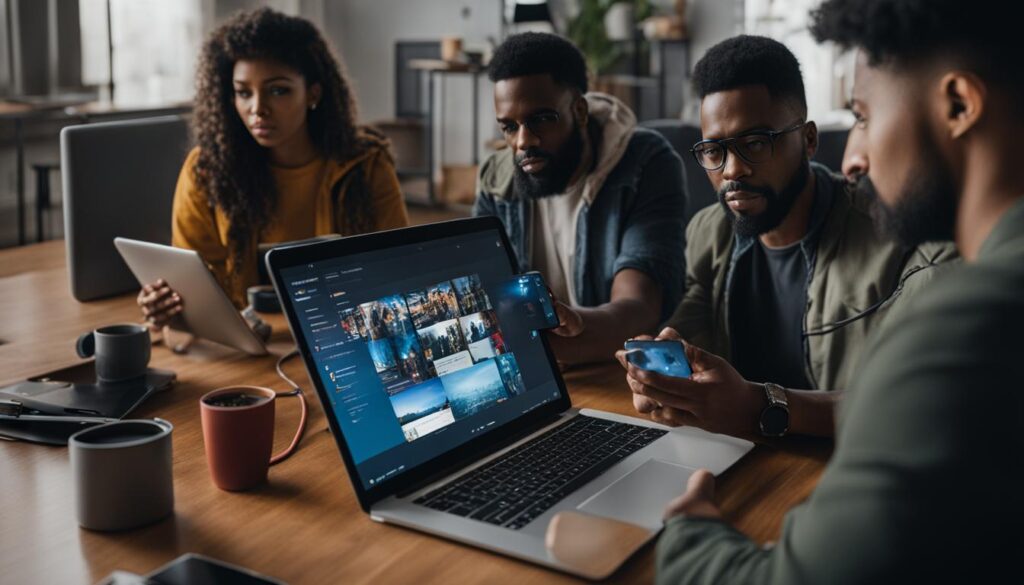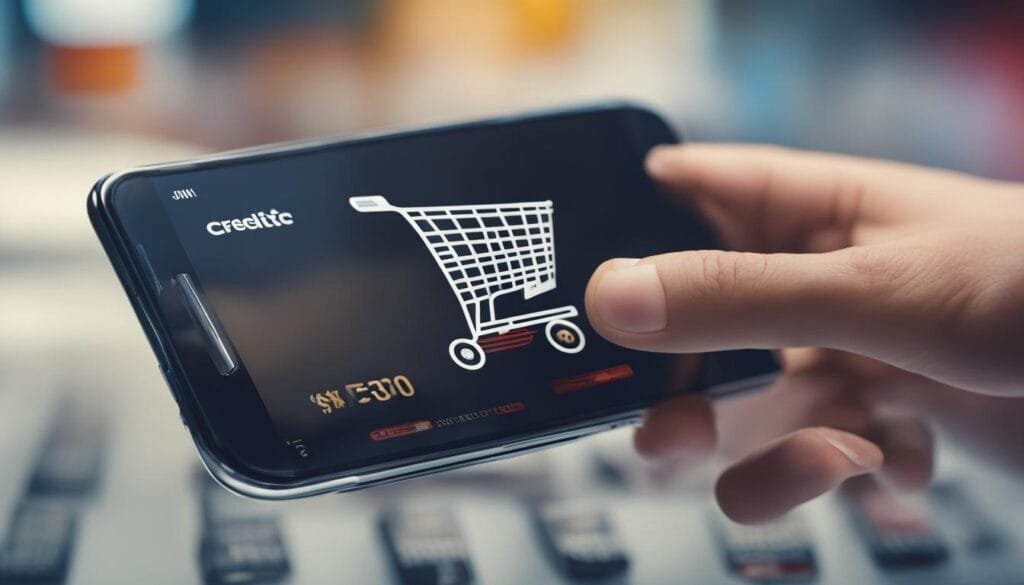Social media is not just for connecting with friends and sharing vacation photos. It can also be a powerful tool for building emergency funds and securing financial safety. In this article, we will explore how individuals can leverage social media tips and strategies to effectively save and prepare for unexpected expenses.
By utilizing the power of social media, individuals can assess their financial needs, make a plan, and engage their support network to stay safe during emergencies. Whether it’s through posting valuable information, utilizing relevant hashtags, or incorporating visually appealing graphics, social media provides a platform for individuals to proactively prepare for unforeseen circumstances.
Key Takeaways:
- Social media can be a valuable tool for building emergency funds and securing financial safety.
- Utilize social media to assess your financial needs, make a plan, and engage your support network.
- Posting information, utilizing hashtags, and incorporating graphics can enhance your financial preparedness efforts on social media.
- Stay informed and connected by following relevant accounts and hashtags focused on financial planning.
- Take advantage of resources and advice shared on social media platforms to create a financial cushion for emergencies.
Importance of Older Adult Preparedness in National Preparedness Month
National Preparedness Month serves as a reminder of the critical need for older adult preparedness in the face of emergencies and extreme weather events. Older adults, particularly those who live alone, have low income, disabilities, or reside in rural areas, are more vulnerable during disasters. To mitigate these risks, FEMA works with critical partners, emergency managers, and older adult communities to provide resources, messaging, and graphics that empower older adults to assess their needs, make a plan, and engage their support network.
It is essential to recognize the unique challenges that older adults face during emergencies. Many may have limited mobility, chronic health conditions, or rely on assistive devices. By understanding these specific needs, emergency preparedness efforts can be tailored to address them effectively. Additionally, older adults may require assistance in accessing reliable information and resources, which can be facilitated through targeted social media campaigns and community outreach programs.
During National Preparedness Month, it is crucial to raise awareness about the importance of older adult preparedness. This includes encouraging older adults to create an emergency kit with essential supplies, develop a communication plan with family and friends, and stay informed about local emergency alerts and evacuation procedures. By empowering older adults to be proactive in their preparedness efforts, we can help ensure their safety and well-being in times of crisis.
| Key Points | Actions |
|---|---|
| Assess specific needs and vulnerabilities of older adults | Create targeted messaging and graphics for older adult communities |
| Encourage older adults to develop a communication plan | Provide resources and information on emergency kits |
| Raise awareness about local emergency alerts and evacuation procedures | Facilitate community outreach to support older adults |
By prioritizing older adult preparedness and fostering a culture of readiness, we can enhance the resilience and safety of our communities. National Preparedness Month serves as a valuable opportunity to educate and engage older adults in emergency planning efforts, ensuring that they are well-equipped to face any future challenges that may arise.
The Role of Social Media in Emergency Response
Social media platforms have become an integral part of emergency response efforts, playing a crucial role in communication and information sharing. During times of crisis, platforms like Twitter, Facebook, Instagram, and others are widely used by emergency management, healthcare, and public health professionals to disseminate important updates, correct misinformation, and address public concerns.
Through social media, authorities can post vital information for public knowledge, such as evacuation orders, shelter locations, and emergency contact numbers. These platforms also provide a means for the public to ask questions, seek clarifications, and report emergencies in real-time, enabling a more rapid and efficient response.
“Social media is a game-changer in emergency response, allowing us to reach a wider audience with critical information and engage in two-way communication,” says Dr. Sarah Johnson, a disaster response specialist. “It helps bridge the gap between emergency responders and the community, fostering a sense of unity and empowerment during challenging times.”
Furthermore, social media platforms enable the sharing and amplification of emergency response messaging through visuals. Infographics, images, and videos can effectively convey important safety instructions or raise awareness about potential hazards. Visual content has been shown to capture more attention and improve information retention, making it a valuable tool in emergency communication.
Example Table: Social Media Platforms and their Role in Emergency Response
| Platform | Role in Emergency Response |
|---|---|
| Real-time updates, news dissemination, emergency hashtags | |
| Sharing emergency information, community support groups | |
| Visual storytelling, infographics, public awareness campaigns | |
| YouTube | Public service announcements, instructional videos |
While social media platforms offer numerous benefits in emergency response, it is important to address the challenges they present. Misinformation, disinformation, and malinformation can spread rapidly, potentially causing panic or hindering response efforts. It is crucial for emergency management agencies and authorities to actively monitor and correct false information, providing accurate updates to the public.
In summary, social media plays a vital role in emergency response by facilitating communication, information sharing, and engagement between emergency responders and the public. By leveraging the power of social media platforms, emergency management professionals can effectively disseminate critical information, address public concerns, and foster a sense of community resilience.
Strategies for Effective Social Media Communication in Emergencies
In times of emergencies, effective communication through social media plays a crucial role in ensuring public safety and crisis response. By leveraging the power of social media platforms, emergency planners and healthcare organizations can disseminate timely information, engage with the public, and coordinate resources more efficiently. Here, we explore some strategies for leveraging social media effectively during emergencies.
Building Community Relationships
One key strategy for effective social media communication in emergencies is building strong community relationships. Healthcare organizations can create dedicated social media accounts to share valuable information, updates, and tips related to emergency planning and preparedness. By actively engaging with their audience, responding to questions and concerns, and providing resources, organizations can foster trust, credibility, and a sense of community. This, in turn, leads to higher levels of engagement and wider dissemination of essential information.
Additionally, healthcare organizations can collaborate with influencers, local community groups, and trusted individuals to amplify their reach and impact. By leveraging existing networks, organizations can tap into established communities and ensure that emergency communication reaches a wider audience. This strategy helps to foster a sense of collective responsibility and encourages individuals to take proactive steps in emergency planning.
Monitoring Potential Threats
In addition to proactive communication, social media can be used as a valuable tool for monitoring potential threats during emergencies. By leveraging data mining and crowdsourcing techniques, emergency planners can gain real-time insights into emerging situations, sentiment analysis, and public concerns. This allows for a more holistic understanding of the situation at hand, enabling effective decision-making, resource allocation, and crisis communication.
Monitoring social media conversations can also help identify and address misinformation or rumors that may be circulating during emergencies. By promptly correcting false information and providing accurate updates, emergency planners can help mitigate panic, confusion, and the spread of misinformation. This is particularly important in ensuring that the public receives reliable and trustworthy information from official sources.
Addressing Mis- and Disinformation
While social media provides a powerful platform for communication during emergencies, it is important to address the challenge of mis- and disinformation. Measures should be put in place to ensure the accuracy and reliability of information shared on social media platforms. This can include implementing security measures to verify the identities of official accounts, establishing incident response plans to address misinformation in real-time, and collaborating with social media platforms to monitor and remove false or misleading content.
By effectively addressing mis- and disinformation, emergency planners can maintain the public’s trust, prevent panic, and ensure that accurate information reaches those who need it most. This underscores the critical need for clear, concise, and reliable communication during emergencies to protect lives and promote effective crisis response.

| Key Strategies for Effective Social Media Communication in Emergencies |
|---|
| Build community relationships through active engagement and resource sharing. |
| Monitor potential threats through data mining and crowdsourcing techniques. |
| Address mis- and disinformation through security measures and incident response plans. |
Hidden Devices and Wireless Emergency Alerts: Protecting Domestic Violence Survivors
Domestic violence survivors often rely on hidden devices as a lifeline for connection and safety. These hidden phones provide a means of communication and access to resources, allowing survivors to seek help and support discreetly. However, the rise of Wireless Emergency Alerts (WEA) poses new risks for domestic violence survivors.

Wireless Emergency Alerts are designed to notify individuals of imminent threats, such as severe weather conditions or public safety emergencies. While these alerts serve an important purpose in keeping the public informed, they can inadvertently alert abusers to the existence of hidden phones.
To protect domestic violence survivors, it is recommended that they power off their hidden devices during WEA tests to avoid detection. This precaution can help maintain the secrecy and safety that hidden devices provide. However, it is important to note that the decision to have a hidden device should be based on an individual’s safety and risk factors. Survivors should seek support from national hotlines and access resources for securing their devices and accounts.
| Protective Measures | Recommendations |
|---|---|
| Power off hidden devices during WEA tests | Ensure devices remain undetectable by abusers |
| Seek support from national hotlines | Access resources for securing devices and accounts |
Leveraging Social Media for Financial Resilience
Social media platforms have become powerful tools for individuals seeking to build financial resilience and secure their financial future. By following accounts and hashtags focused on financial planning, individuals can gain access to a wealth of savings strategies and advice. Social media not only provides a platform for learning and sharing financial knowledge but also enables individuals to connect with financial experts and participate in financial challenges that promote saving habits. Through the power of social media, individuals can take control of their financial planning and create a solid foundation for their financial security.
One of the key benefits of using social media for financial resilience is the ability to connect with like-minded individuals and expand one’s financial network. By engaging with others who share similar financial goals, individuals can exchange ideas, share success stories, and learn from each other’s experiences. This virtual community provides valuable support and encouragement, reinforcing positive financial behaviors and motivating individuals to stay on track with their savings goals.
In addition to connecting with peers, social media platforms can also connect individuals with financial experts who offer valuable insights and guidance. Many financial professionals have established a presence on social media, providing tips, strategies, and resources to help individuals navigate their financial journey. Whether it’s advice on budgeting, investing, or debt management, social media offers a convenient and accessible way to access expert knowledge and stay informed about the latest financial trends.
| Benefits of Leveraging Social Media for Financial Resilience |
|---|
| Access to savings strategies and advice |
| Opportunity to connect with financial experts |
| Engage with a supportive community |
| Stay informed about financial trends |
Furthermore, social media can serve as a platform for financial challenges and initiatives that encourage individuals to save money. These challenges often involve setting specific savings goals, tracking progress, and sharing achievements. By participating in these challenges, individuals can cultivate healthy saving habits, stay motivated, and learn from others who are also on a savings journey. The gamified nature of these challenges adds an element of fun and competition, making saving money more engaging and enjoyable.
By leveraging social media for financial resilience, individuals can gain access to valuable savings strategies, connect with financial experts, engage with a supportive community, and stay informed about financial trends. Social media platforms provide a convenient and accessible avenue for individuals to take control of their financial planning and lay the groundwork for a secure financial future.

Conclusion
In conclusion, social media proves to be a valuable tool for individuals looking to build emergency funds and ensure financial safety. By leveraging social media tips and strategies, individuals can effectively save and prepare for unexpected expenses. Whether it’s through posting information, utilizing hashtags, or incorporating graphics, social media provides a platform for assessing needs, making a plan, and engaging a support network during emergencies.
Furthermore, social media plays a crucial role in emergency response and communication. Platforms like Twitter, Facebook, and Instagram are essential for disseminating real-time updates, correcting misinformation, and fostering bi-directional communication. However, it is important to be mindful of the risks associated with social media, such as the spread of misinformation and privacy concerns.
To maximize the benefits of social media for financial resilience, individuals can follow accounts and hashtags focused on financial planning. Through social media, individuals can access savings strategies, connect with financial experts, participate in financial challenges, and learn about resources for building savings. By taking advantage of social media, individuals can take control of their financial future and create a solid financial cushion for emergencies.
FAQ
How can social media help with building emergency funds?
Social media can provide tips and strategies for effective saving and preparation for unexpected expenses.
What risks do older adults face during disasters?
Older adults, especially those who live alone, have low income, disabilities, or reside in rural areas, face greater risks during disasters.
How can social media platforms be used in emergency management?
Social media platforms can be used for posting information, correcting misinformation, obtaining incident information, and addressing questions and issues in emergency management.
How can healthcare organizations utilize social media during emergencies?
Healthcare organizations can use social media to build community relationships, emphasize preparedness, and monitor potential threats to public health.
What precautions should domestic violence survivors take with hidden devices?
Domestic violence survivors are advised to power off their devices during Wireless Emergency Alert tests to avoid detection.
How can social media help with financial resilience?
By following accounts and hashtags focused on financial planning, individuals can gain access to savings strategies and advice.
How Can Social Media Scams Affect My Financial Security?
It’s crucial to be vigilant about protecting your finances from scams, especially on social media platforms. These scams can lead to devastating financial losses if you’re not careful. By staying informed and adopting proactive measures, such as verifying offers and refraining from sharing sensitive information online, you can shield yourself from potential harm. Safeguarding your financial security should always be a top priority.


Pingback: Budgeting for Social Media Advertising Without Breaking the Bank – Straight Fire Money